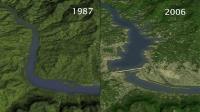Before and after
 NASA satellite images showing the Yangtze River before and after the dam construction
NASA satellite images showing the Yangtze River before and after the dam construction
The Yangtze River: 1987 vs 2006
Among the many programmes that make up the NASA (National Aeronautics and Space Administration) organisation, one is the Landsat Program.
'The Landsat Program is a series of earth-observing satellite missions jointly managed by NASA and the U.S. Geological Survey. Since 1972, Landsat satellites have collected information about earth from space. This science, known as remote sensing, has matured with the Landsat Program.Landsat satellites have taken specialised digital photographs of earth's continents and surrounding coastal regions for over four decades, enabling people to study many aspects of our planet and to evaluate the dynamic changes caused by both natural processes and human practices.'
Of particular interest for this resource is Landsat's cataloguing of images related to the Three Gorges Dam. In the article, Rise of the Three Gorges Dam, NASA states that the Three Gorges Dam is 'One of the few man-made structures so enormous that it's actually visible to the naked eye from space'.
Observations from the NASA-built Landsat satellites provide an overview of the dam's construction. The earliest data set, from 1987, shows the region prior to start of construction. By 2000, construction along each riverbank was underway, but sediment-filled water still flowed through a narrow channel near the river's south bank. The 2004 data shows development of the main wall and the partial filling of the reservoir, including numerous side canyons. By mid-2006, construction of the main wall was completed and a reservoir more than two miles (three kilometres) across had filled just upstream of the dam.
With this featured resource NASA's Scientific Visualization Studio has created an animated visualisation where the camera flies in to the region from outer space, zooming in on the Yangtze River as it appears according to 2006 data showing the high water levels that have already filled the multiple gorges upstream. The animation then transitions to the river at pre-dam 1987 before placing the dam and showing the upstream reservoir filling. The visualisation concludes with a split screen view allowing direct comparison between the 1987 and 2006 upstream levels, clearly depicting the flooding of the Yangtze's riverbanks and many adjacent valleys.